Hey everyone,
I'm looking for anything to give me some help in my dino battle. I'll attach some pictures so please correct me if i am wrong, but I believe it's dino.
Been battling to keep it under control but the new lights seem to have really set it off.
I run a AIO Fluval marine 123L aquarium with customised filtration as there is no sump. Setup 12 months ago fully cycled
Filtration chambers include
Fine filter floss to help accumulate nitrates
Aquaforest brand Carbon pellets
And a combined almost 1ltr of seachem matrix split between the two chambers.
Dalua great white return pump 3000lph with dual RFG nozzles
ATO to reduce salinity swings
I also have a redstarfish DCSQ70 Mini Skimmer which does a remarkable job as well.
I have a deep sandbed of fine grain Oolitic aragonite to aid in nitrogen cycle completion.
There is rough 6 to 8 kg of live rock which have been in my past aquariums for the past 3 years
There are 12 bioballs in the sand bed as well.
Tank inhabitants include:
Green bubble tip Anemone and my pair of clowns.
Firework clove polyp colony
Acan Lord
2 mushrooms
Bright pink gonipora
3 Trochus snails
6 Nassarius snails
1 Sand sifting starfish
1 peppermint shrimp
100 turbo snails lol they bred and ka boom! Of those 6 are adult size.
1 strombus snail.
A sizeable population of copepods and amphipods.
Lighting was recently upgraded to a kessil AP700, which I am acclimating and its only ramping to 40% maximum at the moment but its a flipping fantastic light so far im super impressed by it!
It's running a 12 hour cycle
1030 -1130am: 20% intensity between 3rd and 4th bluest setting
1130 -730pm: 40% intensity between 3rd and 4th bluest setting
730 - 830pm: 20% intensity between 3rd and 4th bluest setting
830pm-1030am: 0%
I need advice because I have been considering buying a cheap uv sterilizer to be placed in the rear chamber something to help with the neutralising the ability of the bacteria to multiply.
I am aware an in line sterilizer would work more efficiently but I simply am trying to keep it as AIO as I can.
Do you all think this would be a viable option for me, would it have the desired effect?
I am cleaning dino's out and supplementing nitrates and phosphates as needed when tested, have turned skimmer off and am feeding more frequently but the the problem is the multiplication rate obviously its still going while im sleeping so I thought a Uv sterilizer might help me get the upper hand.
I have considered a black out period but my corals were strugging under the previous light so they need the new one too much at the moment to justify depriving them just to make life hard for the dino's.

Thanks in advance
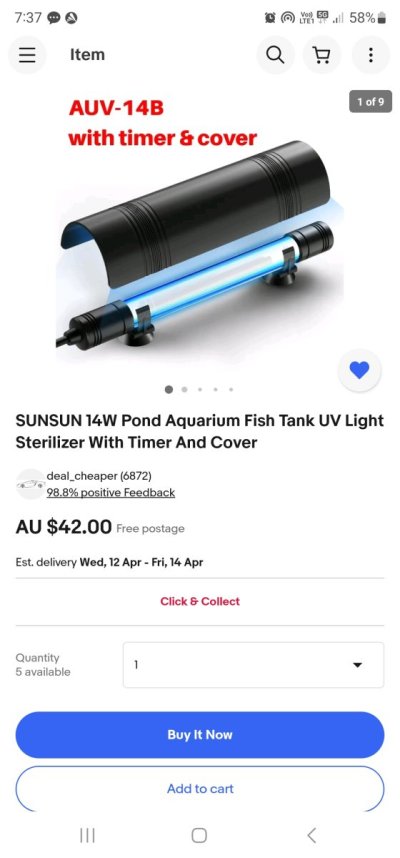
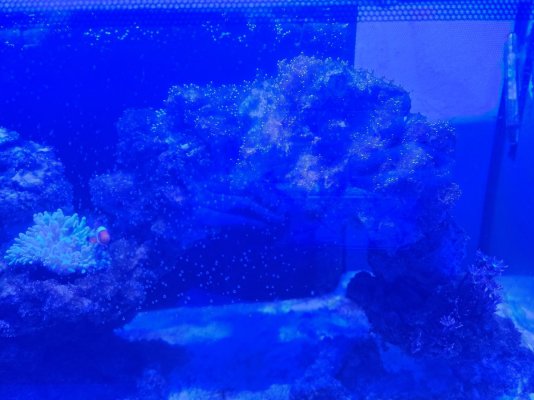
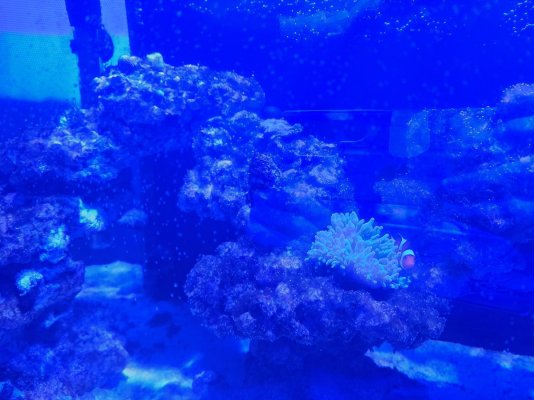
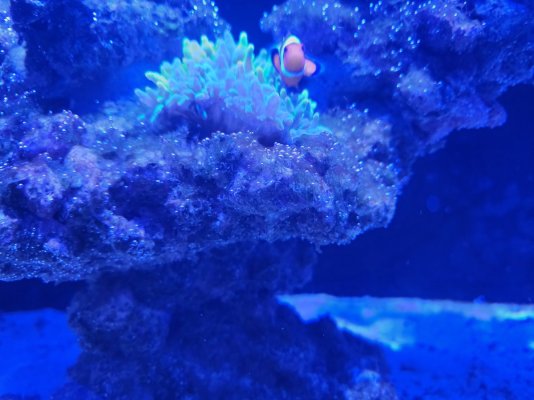
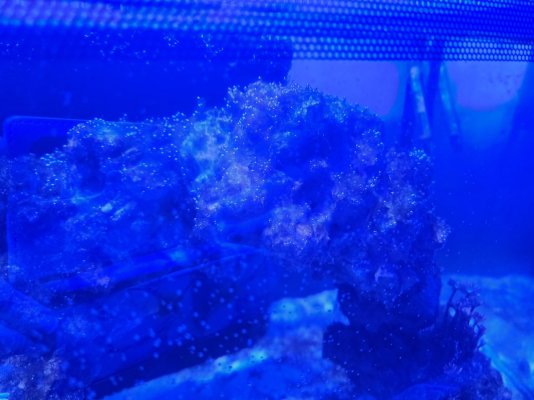
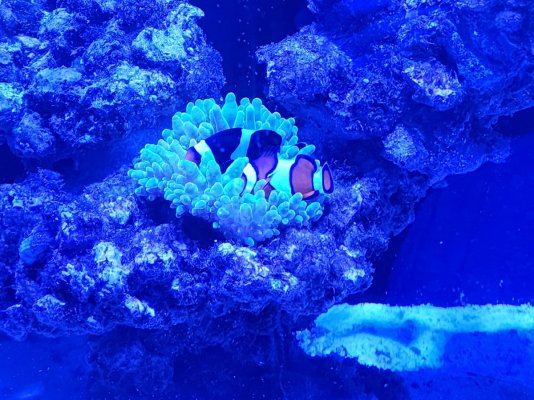
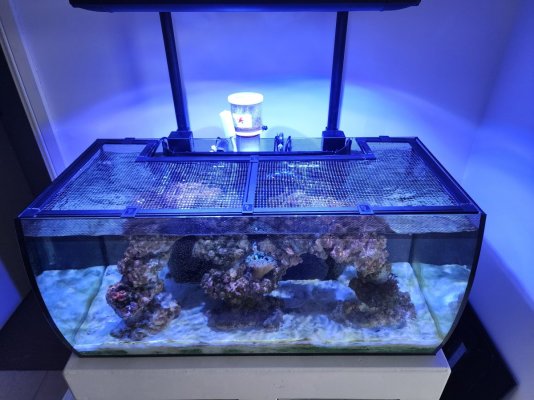
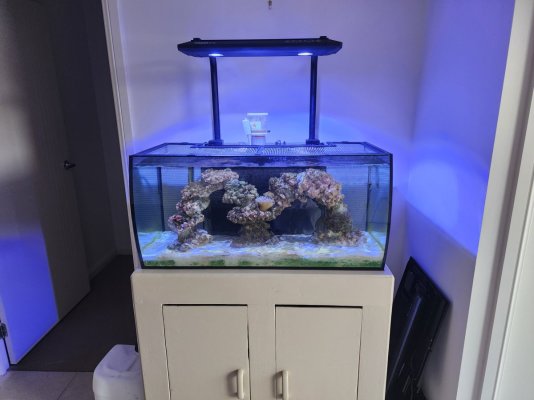
I'm looking for anything to give me some help in my dino battle. I'll attach some pictures so please correct me if i am wrong, but I believe it's dino.
Been battling to keep it under control but the new lights seem to have really set it off.
I run a AIO Fluval marine 123L aquarium with customised filtration as there is no sump. Setup 12 months ago fully cycled
Filtration chambers include
Fine filter floss to help accumulate nitrates
Aquaforest brand Carbon pellets
And a combined almost 1ltr of seachem matrix split between the two chambers.
Dalua great white return pump 3000lph with dual RFG nozzles
ATO to reduce salinity swings
I also have a redstarfish DCSQ70 Mini Skimmer which does a remarkable job as well.
I have a deep sandbed of fine grain Oolitic aragonite to aid in nitrogen cycle completion.
There is rough 6 to 8 kg of live rock which have been in my past aquariums for the past 3 years
There are 12 bioballs in the sand bed as well.
Tank inhabitants include:
Green bubble tip Anemone and my pair of clowns.
Firework clove polyp colony
Acan Lord
2 mushrooms
Bright pink gonipora
3 Trochus snails
6 Nassarius snails
1 Sand sifting starfish
1 peppermint shrimp
100 turbo snails lol they bred and ka boom! Of those 6 are adult size.
1 strombus snail.
A sizeable population of copepods and amphipods.
Lighting was recently upgraded to a kessil AP700, which I am acclimating and its only ramping to 40% maximum at the moment but its a flipping fantastic light so far im super impressed by it!
It's running a 12 hour cycle
1030 -1130am: 20% intensity between 3rd and 4th bluest setting
1130 -730pm: 40% intensity between 3rd and 4th bluest setting
730 - 830pm: 20% intensity between 3rd and 4th bluest setting
830pm-1030am: 0%
I need advice because I have been considering buying a cheap uv sterilizer to be placed in the rear chamber something to help with the neutralising the ability of the bacteria to multiply.
I am aware an in line sterilizer would work more efficiently but I simply am trying to keep it as AIO as I can.
Do you all think this would be a viable option for me, would it have the desired effect?
I am cleaning dino's out and supplementing nitrates and phosphates as needed when tested, have turned skimmer off and am feeding more frequently but the the problem is the multiplication rate obviously its still going while im sleeping so I thought a Uv sterilizer might help me get the upper hand.
I have considered a black out period but my corals were strugging under the previous light so they need the new one too much at the moment to justify depriving them just to make life hard for the dino's.

SUNSUN 14W Pond Aquarium Fish Tank UV Light Sterilizer With Timer And Cover | eBay
Find many great new & used options and get the best deals for SUNSUN 14W Pond Aquarium Fish Tank UV Light Sterilizer With Timer And Cover at the best online prices at eBay!
www.ebay.com.au
Thanks in advance








Last edited:















